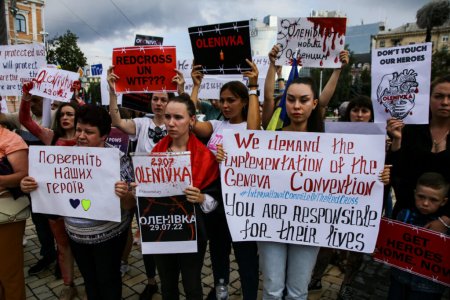
Ukraine’s Prosecutor has initiated a war crimes investigation after drone footage emerged apparently showing Russians killing three Ukrainian soldiers after they had laid down their weapons. If verified, this will be the latest of a rapidly increasing number of such executions by the Russians. All are in flagrant violation of the Third Geneva Convention relative to the Treatment of Prisoners of War, with evidence mounting that rank and file soldiers have been ordered not to take prisoners.
Ukraine’s Prosecutor General and Donetsk Regional Prosecutor reported the latest killing on 5 May 2025, . The three Ukrainian defenders were carrying out military tasks near the village of Novpil (Donetsk oblast) on 3 May when they were surrounded by the enemy who forced them to lay down their weapons and surrender. They were then shot dead in cold blood. The criminal investigation is, as always, under Article 438 § 2 of Ukraine’s Criminal Code (a war crime involving homicide).
There have been a very large number of such criminal investigations since Russia began its full-scale invasion of Ukraine, however it is worth remembering that the first such documented war crimes date back to the beginning of Russia’s military aggression in 2014-15. Late in 2018, Ukraine passed information to the International Criminal Court [ICC] in the Hague about killing by Russians of nine Ukrainian soldiers who had been taken prisoner during the battles for Ilovaisk in late August 2014 and Debaltseve in February 2015. Both of those battles were won, after Russia sent in its own soldiers, as well as military hardware. The documentary evidence included photographic and video evidence, as well as witness testimony, confirming that the Ukrainian soldiers were killed after they had laid down their weapons, and should have been protected under international law as prisoners of war.
Yury Bielousov, Head of Ukraine’s War Crimes Department reported a major increase in Russian executions of Ukrainian POWs, from around November 2023. He stated then that the sharp increase in cases, as well as the fact that these are spread over considerable amounts of territory, indicated that they were not isolated cases, but are part of the Kremlin’s policy. He also pointed to evidence that instructions had been issued on the Russian side to not take enemies.
On 3 February 2025, this major escalation was also reported by the United Nations Human Rights Monitoring Mission in Ukraine. They had documented 79 such executions in 24 separate incidents since August 2024. An entire section of the Office of the High Commissioner for Human Rights 41st report on Ukraine, covering the period from 1 September to 30 November 2024, was devoted to the executions of prisoners of war. One of the 19 incidents which OHCHR had verified was seen in a video where “four Russian servicemen line up and fire automatic rifles at 10 seemingly unarmed Ukrainian servicemen whose bodies then fall to the ground.”
The UN Monitoring Mission have both pointed to evidence that commanders have ordered such executions, or have at least not taken measures to prevent them, and have cited cases where high-level officials have effectively incited people to carry out such war crimes. As Danielle Bell, Head of the Monitoring Mission, put it “these incidents did not occur in a vacuum. Public figures in the Russian Federation have explicitly called for inhumane treatment, and even execution, of captured Ukrainian military personnel. Combined with broad amnesty laws, such statements have the potential to incite or encourage unlawful behaviour.”
While there is ever more documented evidence of such crimes, it is much harder to bring the perpetrators to justice. At present, only one trial is underway in Ukraine of a Russian soldier accused of killing a Ukrainian prisoner of war in cold blood. Dmitry Kurashov was part of a Russian assault unit, made up entirely of convicted criminals who agreed to fight against Ukraine in exchange for their freedom and money. It is Kurashov’s Russian comrades who have said that it was Kurashov who shot dead 41-year-old Ukrainian prisoner of war Vitaliy Khodniuk. Their testimony is also of major importance as the unit’s commander has stated that they were instructed to not take Ukrainian soldiers prisoner (more details here).



